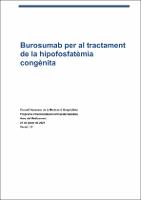Burosumab per al tractament de la hipofosfatèmia congènita
Abstract
X-linked hypophosphatemia (HLX) is a dominant, chronic, and debilitating inherited disease caused by inactivating mutations in the PHEX gene (Phosphate-regulating gene with homologies to endopeptidases on the X chromosome). Although the pathogenesis of HLX is not fully defined, it has been identified that loss of function of the PHEX enzyme leads to increased growth factor of circulating FGF23 fibroblasts, a factor that inhibits the transport of sodium and phosphates. , prevents the activation of vitamin D in the kidneys and promotes the catabolism of active vitamin D. This effect explains most features of the pathology that includes chronic loss of phosphates at the renal level with consequent hypophosphatemia, deficient synthesis of active vitamin D, and abnormal bone mineralization that manifests itself in the form of rickets and osteomalacia, mainly. HLX is a minority disease that accounts for 80% of familial hypophosphatemic rickets. In Europe, the estimated incidence is 1: 20,000 live births and the prevalence ranges from 1.7 to 4.8 per 100,000 people.
Keywords
Burosumab; X-linked hypophosphatemia; Hypophosphatemic rickets; Minority diseaseBibliographic citation
Programa d'Harmonització Farmacoterapèutica. Burosumab per al tractament de la hipofosfatèmia congènita. Barcelona: Servei Català de la Salut; 2021.
Audience
Professionals
This item appears in following collections
The following license files are associated with this item:

 Private area
Private area Contact Us
Contact Us







